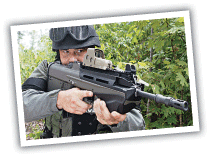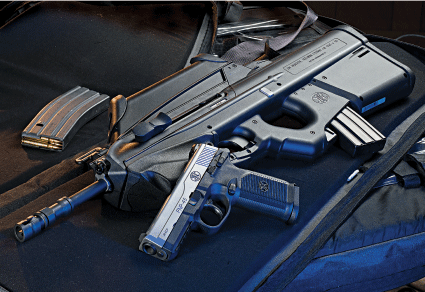IT IS RARE IN THE FIREARMS WORLD that something comes along that is truly new and different, but FNH’s FS2000 is just that; it’s breaking new ground in several ways. The FS2000’s genesis dates to 1995, when FN Herstal began studying what future demands might be for a military rifle to replace current weapons like the M16 and M4. The initial study came to no definite conclusions, but did note that the skills demanded of soldiers were changing given the new roles and missions of military forces worldwide.
 Based on this, the company set out to design a new rifle, which was readily adaptable to alternative configurations based on changing mission profiles, plus being adaptable to incorporate new technical innovations. The result was the F2000, the immediate predecessor of our test rifle.
Based on this, the company set out to design a new rifle, which was readily adaptable to alternative configurations based on changing mission profiles, plus being adaptable to incorporate new technical innovations. The result was the F2000, the immediate predecessor of our test rifle.
Advertisement — Continue Reading Below
The F2000, of course, is select fire, while the FS2000 is not, but other than that the rifles are similar. The original F2000 incorporated an integral 1.6x optical sight. This sight is optional on the FS2000, which comes with a MIL-STD-1913 rail as standard.
Gun Details
For the American market, the F2000 was changed to semi-automatic-only and the barrel was lengthened from 15.5 to 17.4 inches. We actually prefer the US version, not only because it gives better ballistics, but because we think it looks better aesthetically. The lethality issues with short-barreled carbines are well known and the 17.4-inch barrel is very close to the length that the 5.56mm NATO cartridge was originally designed. Thus, the FS2000 should deliver full-length terminal ballistics in a package that is about the same length as an M4A1 carbine with collapsed stock.
The FS2000 is available in two versions, one with 10.5-inch MIL-STD-1913 rail with back-up iron sights installed, the other with FNH’s optional 1.6x optic that blends into the rifle. For the “flattop” version, we installed a L-3 EOTech M553 military Holographic Weapon Sight (HWS).
Advertisement — Continue Reading Below
The FS2000 has so many innovative features it is difficult to begin. Some features are carried over from the P90 5.7x28mm. The safety is ambidextrous and within easy reach of the shooter’s trigger finger. The safety is actuated by a simple short push and gives a positive “click” when engaged or disengaged.
The FS2000’s operating mechanism is entirely encased in polymer, so there are very few openings for foreign matter of any kind to find its way into the gun’s works. This is a very important feature in today’s world, where many military and contractor operations are conducted in “the sandbox” where dust, the consistency of talcum powder, gets into everything. The FS2000 should prove to be very reliable in hostile environments. The only opening exposed to the exterior is a very small linear opening on the stock’s left to accommodate the non-reciprocating charging handle, and the guide rod effectively blocks that. All internal components are essentially sealed.
The FS2000 design also is very smooth with virtually no projections to hang up on straps, lines, vehicle interiors, vegetation or just about anything else. The M16 30-round magazine protrudes only about 2.5 inches outside the stock at its rear and even less at the front, where the pistol grip and magazine release block just about anything from hanging on the magazine. At the forward end, the stock is angled, once again helping to ensure that the muzzle end doesn’t get caught on anything.
Advertisement — Continue Reading Below
The charging handle is on the left side so that right-handed shooters can operate it without removing their strong hand from the rifle. Left-handed shooters will have to reach across to grab the charging handle, but other than the charging handle, the rifle is ambidextrous.
The magazine release is unusual and requires getting used to, but in the final analysis it makes sense. Our first impression was that the magazine doesn’t drop free, which is true as far as it goes. It isn’t intended to drop free, and the actual technique for removing it isn’t covered well in the operator’s manual, one of our few complaints. The magazine was designed to be removed by an individual in NBC (Nuclear, Biological Chemical) gear wearing heavy gloves and to maintain control of the magazine. It is also designed to help keep dust and grit out of the FS2000’s operating system, resulting in a relatively tight fit.
The FS2000 was designed around 30-shot M16 magazines. If you try to use a 20-shot magazine, it will not project below the stock and you will have to disassemble the rifle to remove the magazine. We tried it and it is a monumental pain to get a 20-shot magazine out of an FS2000. For those who want a lower profile magazine, FNH offers a special 10-shot magazine that has an extended base that protrudes just far enough below the FS2000 stock to allow it to be removed.
Advertisement — Continue Reading Below
Underneath the “high-tech” exterior, the FS2000 is equally advanced, with little carried over from earlier designs, except perhaps the multi-lug bolt and chamber, similar to the M16 family. The similarity ends with the multi-lug design, however. The FS2000 extractor is at the 12 o’clock position and, unlike the M16 extractor, is long noted for its inadequate spring; the FS2000 has dual extractor springs for positive engagement.
The “ejector” is also similar to the Garand or M16 in that it is a spring-loaded pin in the bolt face, but it isn’t really an ejector in the traditional sense. Locking and unlocking are via a cam pin and cam in the bolt carrier, again similar to the M16, but not quite the same. The fire control module is made completely of high-strength polymer except for springs and retaining pins. The fire control module’s housing, hammer, sear and all other working components are all polymer and thus are self-lubricating.
The FS2000 is different from just about all other rifles, including other bullpups, and so we must go into some detail regarding its operating system, mainly extraction and ejection of spent cases. The FS2000 ejects cases out the right front. To accomplish this, as a spent case is extracted, it is held in place while a “rocker” assembly tilts to lift it above and clear of the next round in the magazine. As the fresh round is chambered, the spent case enters an ejection tube above the barrel on the right side.
Advertisement — Continue Reading Below
Since the tube is a bit over a foot in length, the first few rounds fired aren’t ejected until the tube is full and the ejection port door is forced open. While this sounds complicated, it really isn’t. The advantage of this, of course, is that spent casings are directed away from personnel alongside the shooter. Once firing has ceased, all that is necessary to clear the tube is to tip the rifle’s muzzle down and all the remaining casings just fall out.
Shooting Impressions
Shooting the FS2000 was a pleasure. The design puts recoil forces in a straight line with the shooter’s shoulder so felt recoil and muzzle rise is virtually nil, thanks also to the rifle’s efficient muzzle brake that serves to keep the muzzle down during rapid-fire strings. The stock positioned our head perfectly for the standard 1.6x and L-3 EOTech optics. The trigger is better than it has a right to be in a rifle that puts the fire control module over a foot behind the trigger and operates it via twin rods, which are almost certainly responsible for the trigger’s “feel.” The trigger has a short, somewhat gritty take-up and then a crisp break at almost exactly 9 pounds, although it felt lighter.
In our testing, the FS2000 proved totally reliable and very accurate. Best accuracy came from Black Hills 77-grain match ammo, but the FS2000 performed well with all ammo tested. Every one of our colleagues who fired the FS2000 had nothing but praise for it, which, coming from a bunch of cops who are naturally skeptical of anything new, is strong endorsement.
Advertisement — Continue Reading Below
We believe that FNH’s FS2000 has taken tactical rifle design to the next level. The FS2000 makes use of state-of-the-art materials in a platform that clearly was designed to cope with the worst conditions imaginable and keep working. For carrying in a cruiser, HMMWV or any other vehicle, the FS2000’s overall length of only 29.3 inches is ideal. Its short length also makes it handy for any CQB operations.
Check out the FN FS2000 CQB 5.56mm!
Advertisement — Continue Reading Below
























